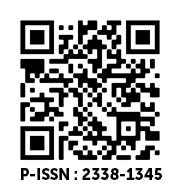Maize Production and Food Security in Garu District of Upper East Region, Ghana
DOI:
https://doi.org/10.36782/apjsafe.v10i2.116Keywords:
Food security; Garu district; Household members; Maize farmers; GhanaAbstract
Agriculture is the dominant occupation in the Garu district that employs over 95 percent of households. However, yields of maize in the district are perpetually low. This might be due to intermittent drought (erratic rainfall pattern), low soil fertility, invasion of diseases and pests, inadequate technical know-how, inadequate credit facilities to expand production and the use of inappropriate farming practices and techniques. The objective of the study was to assess the effect of maize production on food security in Garu district of the Upper East region of Ghana. Purposive sampling technique was used to select Garu district out of the thirteen districts in the Upper East region of Ghana. The purposive sampling technique was again used to select 10 predominantly maize farming communities within the Garu district. The stratified sampling technique was used to selects respondents from the ten communities, while simple random sampling was used to select Agricultural Extension Agents for the study. In all, 124 respondents were selected for the study. The study revealed that over 50% of household members had enough maize to feed on throughout the 12 months period of the year. The study further established that most household made good use of maize as their main diet and nutrition throughout the year. It is recommended that capacity building of farmers on agronomic practices and improved modern methods of farming should be intensified to further sharping the skills of farmers for increased productivity and hence, improved food security. It is also recommended that the Department of Agriculture should ensure effective extension services delivery to increase yields of maize from the average of 4-6 100kg bags per acre to 10 bags per acre.
Downloads
References
Bailey, K.D. 1987. Methods of Social Research, the Free Press, New York.
Bawa, A. 2019. Agriculture and Food Security in Northern Ghana. Asian Journal of Agricultural Extension, Economics and Sociology 31 (2): 1-7. DOI: 10.9734/ajaees/2019/v3li230127.
Bell, J. 1993. Doing your Research Project: A guide for first time researchers in education and social science, Open University Press, UK.
FAO. 2001. Dimensions of need-An Atlas of Food and Agriculture Staple Foods” What do people eat? Food and Agricultural Organization Corporate Document Repository. Produced by Agriculure and Consumer Protection.
Fraenkel J.R. and Wallen, N.E. 2000. How to Design and Evaluate Research in Education, 4th Ed. McGraw Hill Inc., USA.
Hauck, J. and Youkhana, E. 2008. Histories of water and fisheries management in Ghana.
Jamison, D. and Lau, L. 1982. “Farmer Education and Farm Efficiency”. Washington, DC, World Bank.
Lucas, R. 1988. “On The Mechanics of Economic Development”. Journal of Monetary Economics 22: 3-42.
MoFA. 2007. Food and Agriculture Sector Policy Framework. Ministry of Food and Agriculture, Government of Ghana, Accra, Ghana.
Ogwumike, F.O. 2001. Current state of knowledge on poverty in Nigeria. In: Afonja, S., Adelekan, D., Soetan, F., Alimi, T. and Ayanwale, B. (Eds). Research and policy directions on poverty in Nigeria. Nigeria: Centre for Gender and Social Policy Studies; 2001. p. 24–34.
PHC. 2010. The 2010 Population and Housing Census (PHC) reports: Analysis of district data and implications for planning. Published by the Ghana Statistical Service, Accra, Ghana; 2010.
Quisumbing, A.R., Payongayong, E., Aidoo, J.B. and Otsuka, K. 2001. Women’s land rights in the transition to individualized ownership: implications for tree resource management in Western Ghana. Econ Dev Cult Change, 50(1):157–82.
Romer, P. 1986. “Increasing Returns and Long Run Growth”. Journal of Political Economics 94: 1002-1037.
Sarantakos, S. 1993. Social Research, Macmillan Education Pty Ltd., Australia.








